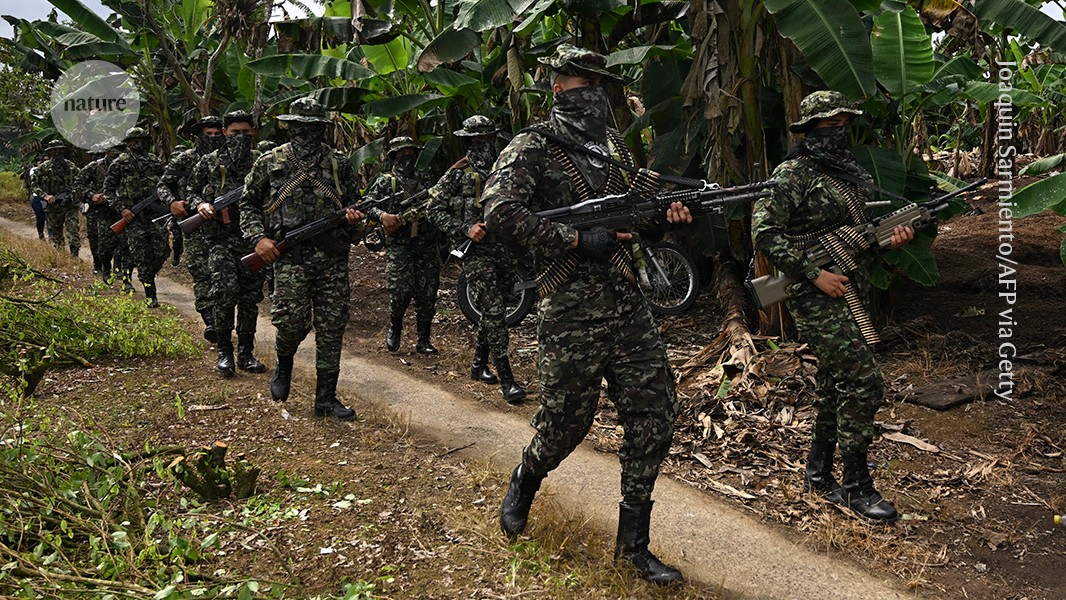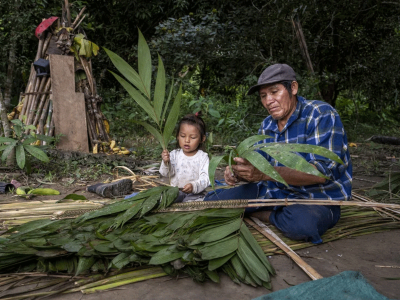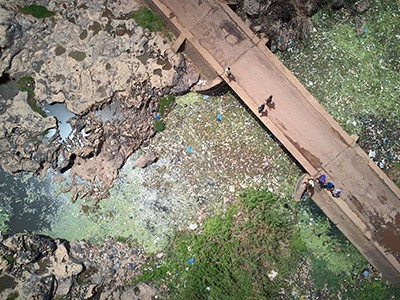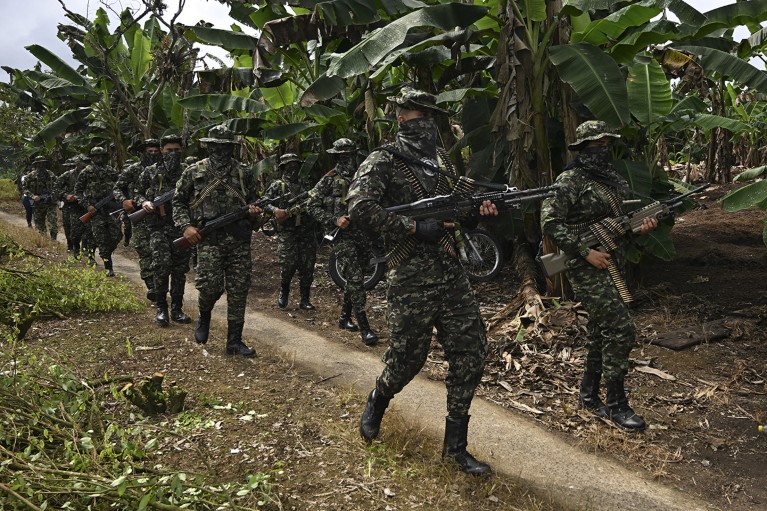
Guerrillas from the FARC movement were involved in a long-running conflict in Colombia, which is one of the world’s most biodiverse countries.Credit: Joaquin Sarmiento/AFP via Getty
Since Russia’s invasion in 2022, 3 million hectares of Ukraine’s protected areas have been affected by military activities1. For example, our independent analysis of satellite imagery shows that in the Sviati Hory (Holy Mountains) National Nature Park in the east of the country, 16% of forested areas have been physically damaged by fires, shelling and the movements of military vehicles (see ‘Assessing impacts in conflict zones’). Protected areas have lost their staff and equipment, and properties have been damaged or destroyed.
Today, more armed conflicts are under way than at any point since the Second World War. Conservationists and others are increasingly investigating the impacts on biodiversity2–4, yet governments and conservation organizations have been reluctant to explicitly address the issue in conservation policy. In 2022, when nearly 200 countries agreed in Montreal, Canada, on the Global Biodiversity Framework — a set of goals intended to prevent catastrophic loss of the world’s biodiversity — armed conflict was left unmentioned.
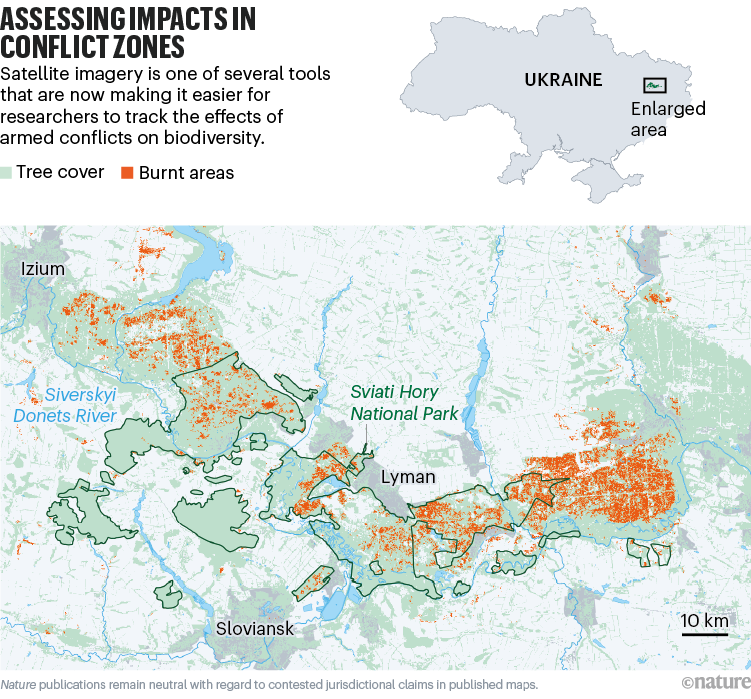
Sources: Land cover: ESA/OpenStreetMap; National park boundaries: Emerald Network; Burnt areas: Analysis by D. Weir et al.
This month, ministers of the environment, conservationists, Indigenous peoples and others are gathering in Cali, Colombia, to help to translate the biodiversity framework into action at the 16th meeting of the Conference of the Parties to the Convention on Biological Diversity (COP16). Colombia is one of the world’s most biodiverse nations. Since 2016, it has also been facing challenges in implementing a peace agreement signed after five decades of conflict, much of which was between its government and the guerrilla movement FARC.
Linking to the experiences of the Colombian people, COP16 organizers have specified that the meeting should be “a COP of the people”, and that it should prioritize “Paz con La Naturaleza” or peace with nature. In doing this, they are encouraging attendees to focus on how the exploitation of natural resources, and the conflict that this brings, can harm biodiversity, as well as on how interventions to protect biodiversity might help to foster peace (see go.nature.com/3y95zgv).
We urge world leaders and conservation, humanitarian and other organizations to follow Colombia’s lead and give greater priority to the impact of armed conflict on biodiversity — and to conservation’s role in promoting peacebuilding — in research and policy agendas.
What’s known
Research on the effects of armed conflicts on ecosystems has been limited for obvious reasons. But over the past decade, the use of satellite imagery, the tracking of social media and other open-source intelligence, and the increasing involvement of local communities in research have allowed investigators to improve monitoring of the impact of armed conflicts in settings that are difficult or dangerous to work in.
Between 1950 and 2000, more than 80% of armed conflicts took place in 34 recognized biodiversity hotspots5. According to data published in July, 39 countries — including many that are rich in biodiversity, such as Colombia, Myanmar, Brazil and Cameroon — are currently experiencing sustained or escalating levels of conflict (see ‘Far-reaching effects’ and go.nature.com/3btgzrn).
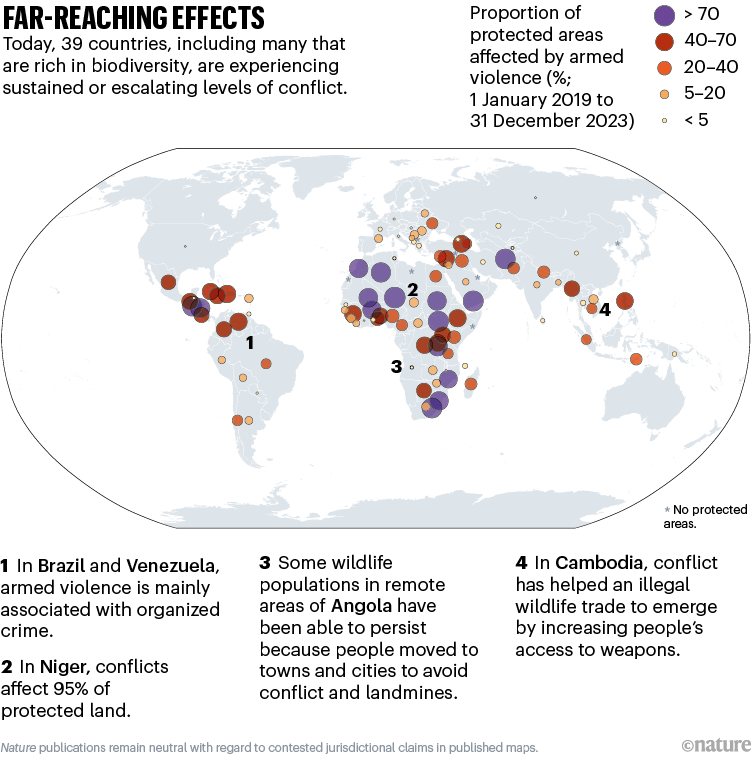
Source: ACLED Conflict Index 2024
The impacts go far beyond the direct effects of warfare. Access to small arms and light weapons, such as pistols, rifles and light machine guns, makes it easier for people to kill animals for bushmeat or trade. Indeed, increases in the ownership of small arms following conflict have been implicated in the decline, and in some cases the extinction, of large mammals across the Sahara–Sahel region of Africa6. Conflict can even bring long-term changes in the threats to wildlife. In Cambodia, for example, increased access to weapons through conflict was one factor that allowed an illegal wildlife trade to emerge, one that continues to supply international markets with (among other items) the body parts of Sunda pangolins (Manis javanica; often called scaly anteaters) and gaur (Bos gaurus, a wild cattle species) for traditional medicine, meat and handicrafts7.
Several studies have shown that illegal hunting and logging often accelerate during and after conflict — either because governance and institutions are weakened, or because traditional management systems disappear when people are displaced8. Likewise, conflicts can increase people’s dependencies on wood for fuel and thereby drive overharvesting9.
No basis for claim that 80% of biodiversity is found in Indigenous territories
The effects of armed conflict on biodiversity can be extremely diverse, depending on the context. In Angola, almost three decades of conflict beginning in the mid-1970s displaced millions of people, which left some areas of the country relatively free of human impacts. Also, the widespread use of landmines (which are still being cleared) prevented people from returning to large areas of wilderness. As a result, certain populations of threatened wildlife species in remote areas of the country, for example in the centre and near the border with Namibia and Zambia, have been able to persist10,11.
Conversely, in some areas closer to urban centres, such as the coastal Quiçama National Park near the capital Luanda, widespread hunting during and after conflict has led to declines in many mammal species12 and probably to the local disappearance of some species, including the common eland (Tragelaphus oryx) and roan antelope (Hippotragus equinus). And since the conflict ceased, large mammal populations across Angola’s wilderness and protected areas have declined owing to a breakdown in law enforcement and governance — disruption that began with the conflict but that persists to this day.
Alongside studies of the effects of conflict on biodiversity, there has been a growing interest in the use of ‘nature-based solutions’ to support people’s well-being and livelihoods during and after conflict — and to help avoid future conflict. As part of the Kibira Peace Forest project, which was established in Burundi in 2021, for example, a coalition of regional and international organizations and donors engaged the government, private sector and local community — particularly women — in the stewardship of biodiversity. An assessment of the project suggests that it strengthened social cohesion and improved people’s livelihoods, which in turn reduced levels of conflict and deforestation (see go.nature.com/47xztpy).
Putting conflict on the table
Promising as these efforts are, much more research is needed — for example, to probe the interactions between biodiversity loss, armed conflict and climate change. There are also questions about whether Indigenous or community-led management of natural resources is more resilient than, say, government management in the face of conflicts. A 2023 study showed that in the world’s biodiversity hotspots, ecosystems on Indigenous peoples’ lands are less degraded than are those on non-Indigenous lands, even though armed conflict is more likely to occur in the former13.

The Kibira Peace Forest project in Burundi, funded by the United Nations Nature Facility, engaged local people in biodiversity stewardship.Credit: UN Capital Development Fund
More immediately, changes to some of the instruments that will be used to implement the Global Biodiversity Framework could help countries to mitigate the impacts of conflict on biodiversity, build biodiversity governance and help to restore biodiversity following conflict.
The Convention on Biological Diversity is the international treaty that governs the conservation of biodiversity, its sustainable use and the sharing of benefits from the use of genetic resources. Since entering into force in 1993, it has been ratified by 196 parties. But it is silent on the issue of conflict. Also, neither the convention’s previous Strategic Plan for Biodiversity and its accompanying Aichi targets, nor its current Global Biodiversity Framework — which lays out 23 actions or targets needed to protect and restore biodiversity between now and 2030 — address the relationship between biodiversity and armed conflict.
Ditching ‘Anthropocene’: why ecologists say the term still matters
In our view, countries should be urged to incorporate language that explicitly considers the needs and challenges arising in the face of armed conflict — and during peacebuilding — in their National Biodiversity Strategy and Action Plans (NBSAPs). These lay out the actions that nations will take to address threats to biodiversity, and so help to achieve the ambitions of the Global Biodiversity Framework. For example, countries could set out how restoration of biodiversity will be used to build and sustain peace. Countries could also include plans to monitor the impact of armed conflict on biodiversity in their NBSAPs. Data on conflicts are already available should governments want to use them, such as the ACLED Conflict Index, which is derived from data on incidents of political violence worldwide.
There is little appetite for adding further indicators to the official list of more than 100 that will be used to monitor progress towards the Global Biodiversity Framework’s targets. Yet the development and future inclusion of indicators that help governments, scientists and policymakers to measure and understand the impact of armed conflicts on the environment and biodiversity over time, and hence their effects on countries’ abilities to deliver on their commitments, could bring tremendous value.
Crucially, more technical and financial support must be directed towards countries affected by conflict. This is especially important during the early years of recovery following conflict, when continuing insecurity and weak environmental governance can exacerbate deforestation and other threats to biodiversity. The Convention on Biological Diversity and other international conservation agreements, such as the Ramsar Convention on Wetlands, represent vehicles for collating expertise, focusing people’s attention and mobilizing funding and technical assistance. These should be harnessed specifically for this purpose.
Donors often view conservation projects in conflict areas as too risky or too prone to failure. This can mean that community projects, local non-governmental organizations and front-line staff, such as rangers, go unsupported. As long as those involved ensure that they have an in-depth understanding of the local context, and prioritize the local ownership of projects and resource management, a shift in mindset would enable the growth of sustainable, impactful conservation projects to mitigate the effects of conflict on biodiversity, and to help to foster peace.
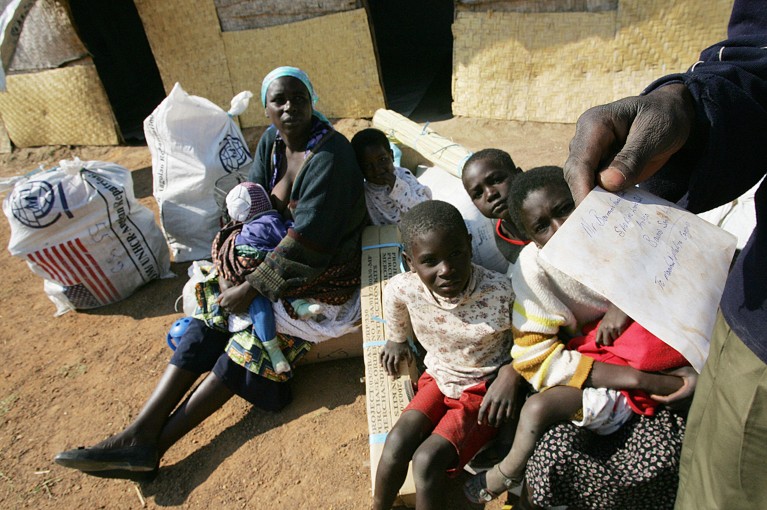
Refugees from Angola who fled the country during its 27-year civil war were able to return after a peace accord was signed in 2002.Credit: Alexander Joe/AFP via Getty
Influential organizations are beginning to make headway on this front. In 2020, the Global Environment Facility, one of the largest international donors supporting biodiversity projects, reviewed its portfolio of projects in ‘fragile states’ (countries with weak governance, chronic humanitarian crises, persistent social tensions and so on) and in countries dealing with ongoing conflict. It identified that ‘conflict-sensitive’ approaches can help to improve the outcomes of conservation projects, and has since been working to update its practices accordingly14. Elsewhere, partnerships between conservation and peacebuilding organizations, such as between Conservation International in Arlington, Virginia, and the PeaceNexus Foundation near Geneva, Switzerland, are beginning to provide insights that could be applied more broadly to projects in challenging settings15.
Ultimately, much greater awareness is needed of the impacts of conflict on biodiversity. Incorporating the issue into the implementation of the Global Biodiversity Framework would be an effective way to achieve this, particularly because conflict reduces the capacity of countries to gather and collate data on biodiversity. Increased awareness could also create opportunities for other organizations to engage, from United Nations peacekeepers to humanitarian organizations. As an example, organizations that clear landmines, such as Norwegian People’s Aid in Oslo, are already increasingly examining how to mitigate the impact of their activities on sensitive habitats.
Following Colombia’s lead
There is now consensus among scientists and most governments that healthy ecosystems are crucial for safeguarding human rights, livelihoods and well-being. Although there will always be limits to the degree of environmental protection that can be achieved in war zones, there are huge opportunities to reduce environmental harm stemming from conflict, to ensure that biodiversity protection in post-conflict recovery efforts becomes mainstream, and to ensure that the environment is integrated into peacebuilding processes.
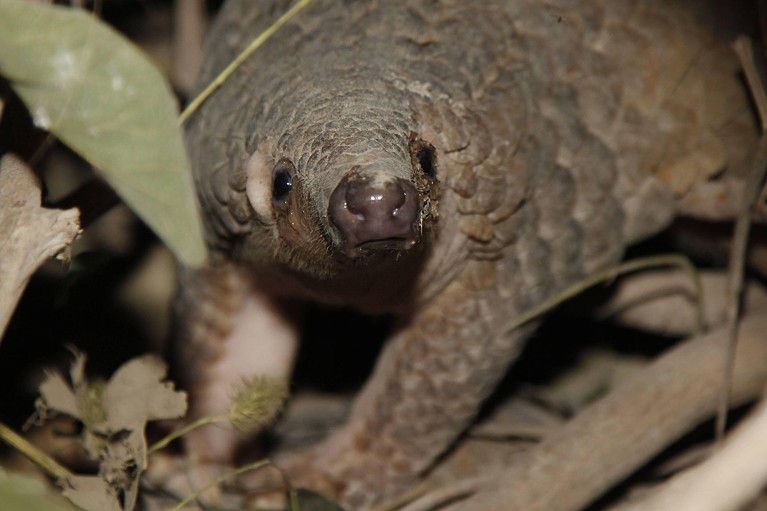
An illegal wildlife trade in Cambodia — driven in part by increased access to weapons through conflict — supplies international markets with the body parts of Sunda pangolins (Manis javanica).Credit: Imago/Alamy
Multiple factors have encouraged Colombia’s COP16 organizers to push the issue at the upcoming meeting. Colombia has endured one of the longest armed conflicts in Latin America, which has been fuelled largely by illicit economies underpinned by natural resources, such as gold and timber, in turn severely harming biodiversity. Even today, ecosystems and local communities, including Indigenous peoples, Afro-Colombians and campesinos (small farmers), are trapped in the middle. And although deforestation in the country was reduced by 36% in 2023 thanks to collaborative work between communities, civil society and the government to protect forests from exploitation, escalating threats to leaders of social and environmental movements could drive rates up again. In the first 9 months of 2024 alone, 117 such leaders were murdered in Colombia.
The links between Colombian biodiversity and conflict are so strong that the environment is included in the country’s Special Jurisdiction for Peace (Jurisdicción Especial para la Paz; JEP). The JEP is a transitional-justice mechanism that was launched in 2017 as part of the peace agreement between FARC guerrillas and the government. In 2019, the government declared that the environment had been a “silent victim of the conflict” and that it would investigate reparation mechanisms for the damage caused.
Against a backdrop of such experiences — which are not unique to Colombia — the country’s two-year presidency of the Convention on Biological Diversity offers an unprecedented opportunity to at last bring attention to the interactions between biodiversity, conflict and peace.


